 Today, I am delighted to introduce guest blogger Dr. Miranda Sachs! Miranda studied History at Princeton University, and graduated in 2011. She worked extensively at our library, both in special collections and with me in community outreach. Miranda earned her PhD at Yale, and is now an assistant professor of European History at Texas State University.
Today, I am delighted to introduce guest blogger Dr. Miranda Sachs! Miranda studied History at Princeton University, and graduated in 2011. She worked extensively at our library, both in special collections and with me in community outreach. Miranda earned her PhD at Yale, and is now an assistant professor of European History at Texas State University.
That’s where she met Percy Jackson.
Or more accurately, that’s where she visited the Rick Riordan archive in Texas State’s Wittliff Collections. The collections “collect, preserve and present the cultural heritage of Texas, the Southwest & Mexico through works of the region’s storytellers—writers, photographers, musicians, filmmakers and other artists,” and Riordan’s papers and ephemera are part of the Southwestern Writers Collections (along Sandra Cisneros, Sam Shepard, Naomi Shihab Nye, Cormac McCarthy, and J. Frank Dobie to name a few).
Miranda found some incredibly cool stuff, and I will now turn the post over to her very capable hands. Take it away, Miranda!
Many, many years ago I was an undergraduate at Princeton and I had the privilege of working for Dr. Dana. It was the best job ever. I did things like glue lizards onto visors for a Holes watch party or tell jokes using a shark puppet. Dr. Dana introduced me to Percy Jackson and I loved the books. I even got to dress as a Greek lady for Princyclopedia, an event that Dr. Dana used to organize.
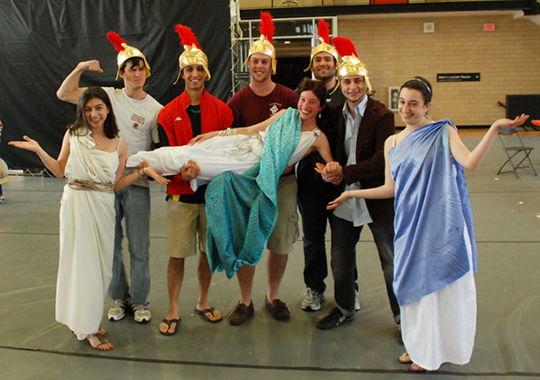
Miranda, on right, being fabulous. Department of Special Collections, Cotsen Children’s Library, Princeton University Library.
Since my time at Princeton, I’ve become a professor of French history. Imagine my surprise and delight when I discovered that Texas State, the university where I teach, has the personal collection of Rick Riordan, the author of the Percy Jackson books. I reached out to my old friend Dr. Dana and she sent me on a quest to check out what Rick Riordan sent to the Witliff Collections.
 Because of the new Lightning Thief mini-series, the library has some of the highlights from Riordan’s collection on display. As soon as I walked in the door, I saw a shirt for Camp Half-Blood. The display case had a replica of Riptide used for the film and some neat photos of Riordan speaking to kids. It also had hand-written copies of stories Riordan wrote as a kid! The room where I got to look at the documents had art on display from the covers of some of the books.
Because of the new Lightning Thief mini-series, the library has some of the highlights from Riordan’s collection on display. As soon as I walked in the door, I saw a shirt for Camp Half-Blood. The display case had a replica of Riptide used for the film and some neat photos of Riordan speaking to kids. It also had hand-written copies of stories Riordan wrote as a kid! The room where I got to look at the documents had art on display from the covers of some of the books.

The archivist let me look at some of Rick Riordan’s childhood stories. It turns out that Riordan was writing fantasy and mythology even back then. One story was about a god named Jzais living in a world called Tharcas. He wrote some of these stories by hand and others with a typewriter (yup, he was a kid before the computer.)
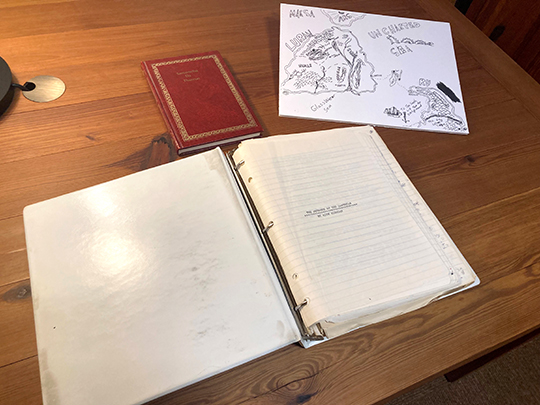
All the stories were on the original pieces of paper on which he’d written or typed. It was fun to look at stories he wrote in junior high school (back in 1978) and see comments from his teachers. One story called “The Ring of Fire” received 100/100!
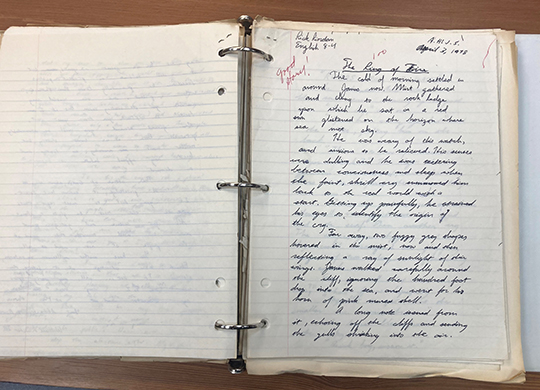
Rick Riordan was a teacher before he was a writer. One of the boxes in the collection includes a photo album with pictures from the final class of students he taught in 2004. Six years later, he went back to visit the school and those kids were seniors. Many of them wrote letters sharing how much he had meant to them as a teacher. They still remembered the story of Gilgamesh because he had told it to them with funny voices. Multiple kids recalled that they had carried out a mock trial using Hammurabi’s Code in his class. It seems that Riordan was a creative teacher who got kids excited about the ancient world even before he published the Percy Jackson books.

My favorite thing to look at was fan letters from kids. Some of the kids were harsh critics. A 7th grader named Caitlyn complained that the books droned on, and it took too long to get to the exciting parts. A boy named Sean was confused why Percy was dry when he came out of the water given that his father was the sea god. Others asked great questions. They wanted to know his favorite character and his favorite band. A girl named Lauren asked “ARE YOU A HALF BLOOD?” Another girl was curious if he would consider casting Arnold Schwarzenegger as Zeus in the film adaptation. (Sorry.)
Mostly, the kids wanted to express how much they loved the books. By the time Sea of Monsters came out, Riordan was getting multiple letters each day. It was super cool to see evidence of how much those books meant to kids. It was also cool to think that Riordan chose to save the kids’ letters. He decided they needed to be preserved in the archive alongside his fancy prizes and the early drafts of his books.
Before I left, I asked to hold Riptide. It was surprisingly heavy. I guess I’m not a demigod…

Photo by Katie Salzmann
We would like to thank Texas State University for so generously sharing their collections, and to Miranda for being awesome (as always!). Miranda is also an author! She published a book all about kids in nineteenth-century Paris called An Age to Work: Working-Class Childhood in Third Republic Paris.
Collections images courtesy of Miranda Sachs

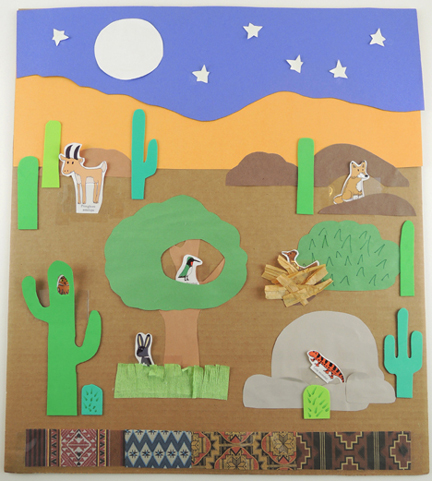 Settle down Southwestern critters! As the moon rises over the cacti in this lovely construction paper landscape, it’s time for the birds, animals, and reptiles to find their special spots. Turn off the lights, and your moon and stars glow in the dark!
Settle down Southwestern critters! As the moon rises over the cacti in this lovely construction paper landscape, it’s time for the birds, animals, and reptiles to find their special spots. Turn off the lights, and your moon and stars glow in the dark!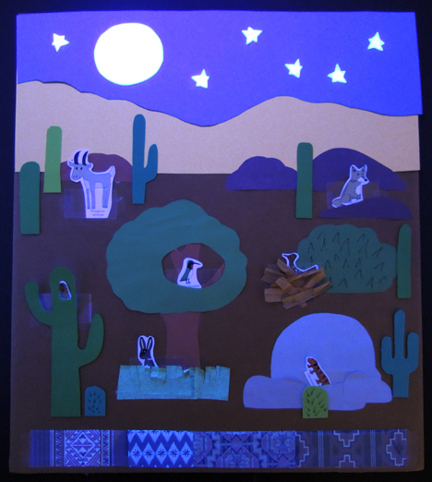 We read Bedtime in the Southwest by Mona Hodgson, illustrated by Renée Graef (Rising Moon, 2004). Twilight has come to the Southwest, and it’s time to go to bed. But is everyone ready? The little hare is hopping on his bed, the skunk appears to be ignoring Mama, and the porcupine is poking quills in his pillow in protest. But eventually, everyone scoots, snuggles, and nestles down to sleep.
We read Bedtime in the Southwest by Mona Hodgson, illustrated by Renée Graef (Rising Moon, 2004). Twilight has come to the Southwest, and it’s time to go to bed. But is everyone ready? The little hare is hopping on his bed, the skunk appears to be ignoring Mama, and the porcupine is poking quills in his pillow in protest. But eventually, everyone scoots, snuggles, and nestles down to sleep.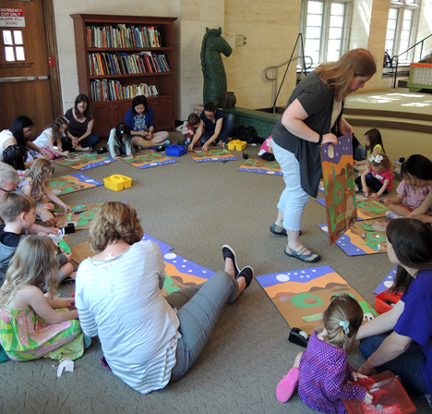 We also prepped all the project items in advance, so it would be easier for the entire group to progress through the project together.
We also prepped all the project items in advance, so it would be easier for the entire group to progress through the project together. As you can see, the pronghorn habitat is a small bump of brown construction paper with a pocket taped in front of it. Super easy! The coyote habitat is 3 brown dirt mounds, one cut to look like the entrance to a burrow. The pocket is taped behind one of the mounds.
As you can see, the pronghorn habitat is a small bump of brown construction paper with a pocket taped in front of it. Super easy! The coyote habitat is 3 brown dirt mounds, one cut to look like the entrance to a burrow. The pocket is taped behind one of the mounds. The roadrunner habitat is a big spiky green bush with a little construction paper nest in front of it (the pocket is under the nest). Then we we then covered the nest with (optional) brown
The roadrunner habitat is a big spiky green bush with a little construction paper nest in front of it (the pocket is under the nest). Then we we then covered the nest with (optional) brown  The gila monster habitat is 4 gray rocks, with the pocket behind 3 overlapping rocks.
The gila monster habitat is 4 gray rocks, with the pocket behind 3 overlapping rocks.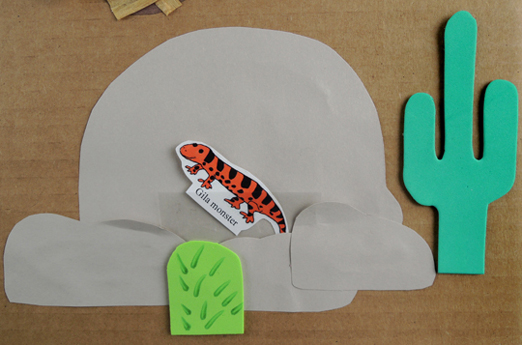 For the hummingbird habitat, cut a branched tree trunk out of brown construction paper, then tape the pocket over a fork in one of the branches. Cut a tree canopy with a big hole in it, then glue it over the top of the tree trunk and the pocket, leaving plenty of room to slide the hummingbird in and out. The hare habitat is at the bottom of the tree. It’s a pocket covered by a fringed 6″ piece of green crepe paper (or just use construction paper).
For the hummingbird habitat, cut a branched tree trunk out of brown construction paper, then tape the pocket over a fork in one of the branches. Cut a tree canopy with a big hole in it, then glue it over the top of the tree trunk and the pocket, leaving plenty of room to slide the hummingbird in and out. The hare habitat is at the bottom of the tree. It’s a pocket covered by a fringed 6″ piece of green crepe paper (or just use construction paper).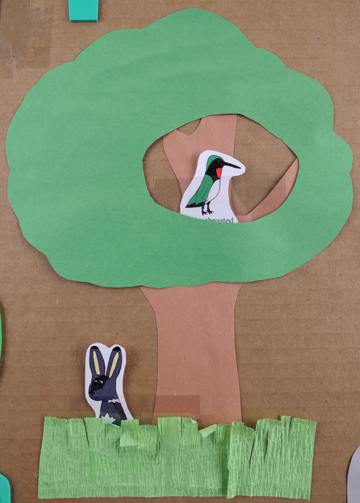 Finally, the elf owl. Did you know that elf owls live in cacti? We wanted to capture that awesomeness, so Katie painstakingly cut holes in 2 dozen cacti. Tape the owl’s pocket directly to the board, slide the owl in the pocket, and then position the hole in the cactus directly over the owl’s face.
Finally, the elf owl. Did you know that elf owls live in cacti? We wanted to capture that awesomeness, so Katie painstakingly cut holes in 2 dozen cacti. Tape the owl’s pocket directly to the board, slide the owl in the pocket, and then position the hole in the cactus directly over the owl’s face.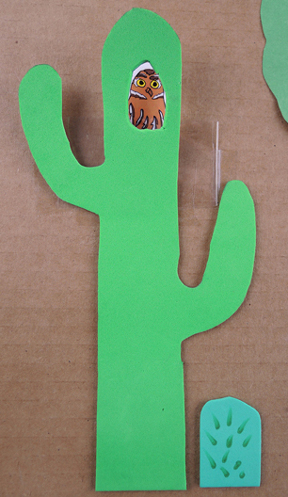 Because you need to retrieve your owl, you only want to attach the bottom section of the cactus to the board. We used self-adhesive foam for our cacti, and solved the problem by leaving the paper backing on the top part of the cactus, but peeling and sticking the rest:
Because you need to retrieve your owl, you only want to attach the bottom section of the cactus to the board. We used self-adhesive foam for our cacti, and solved the problem by leaving the paper backing on the top part of the cactus, but peeling and sticking the rest: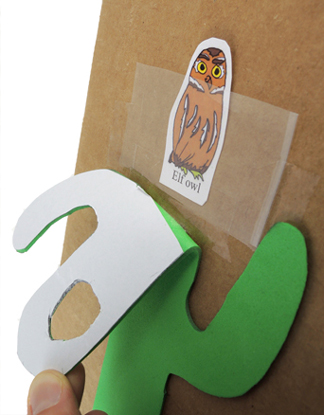 We used self-adhesive foam for all our cacti. It gave them a terrific texture, and it was fun for the kids to peel and stick them wherever they wanted. But construction paper works too! At the very bottom of our background boards was a long mylar pocket to store the animals when they’re not tucked into their habitats. We slid some cool Southwestern patterned paper into the pocket too.
We used self-adhesive foam for all our cacti. It gave them a terrific texture, and it was fun for the kids to peel and stick them wherever they wanted. But construction paper works too! At the very bottom of our background boards was a long mylar pocket to store the animals when they’re not tucked into their habitats. We slid some cool Southwestern patterned paper into the pocket too.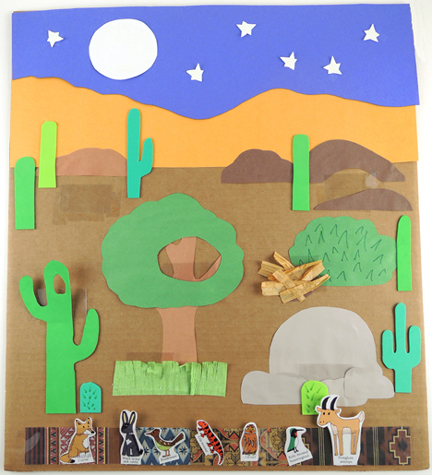 You might have noticed that we kept the names of the critters on our template cut outs. I also broke from tradition and presented them to the kids already colored in. That’s because we wanted the kids to see what the various Southwestern critters looked like, and to learn their names. However, if you’d like the same template in black & white,
You might have noticed that we kept the names of the critters on our template cut outs. I also broke from tradition and presented them to the kids already colored in. That’s because we wanted the kids to see what the various Southwestern critters looked like, and to learn their names. However, if you’d like the same template in black & white, 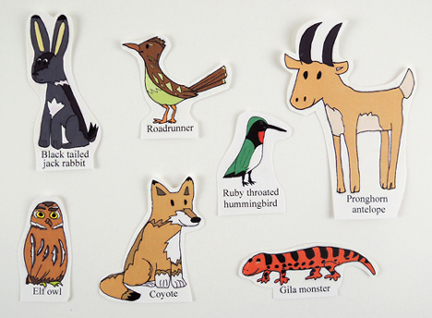 The very last thing Katie and I did was go around with a bit of glow-in-the-dark paint and fill in their moon and stars. We also added optional shooting stars (by painting glowing lines behind one of the stars on the board).
The very last thing Katie and I did was go around with a bit of glow-in-the-dark paint and fill in their moon and stars. We also added optional shooting stars (by painting glowing lines behind one of the stars on the board).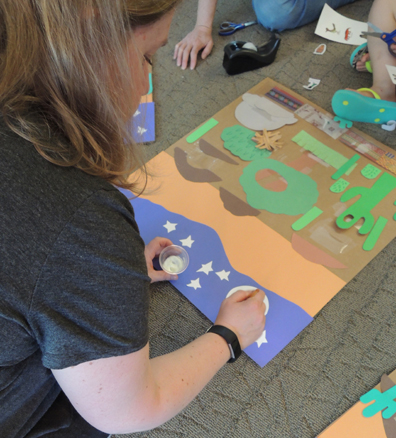 And that’s it! I like to think that, later that night, little Southwestern landscapes were glowing softly across town as kids tucked the animals in and went to sleep. Goodnight, sweet Southwest.
And that’s it! I like to think that, later that night, little Southwestern landscapes were glowing softly across town as kids tucked the animals in and went to sleep. Goodnight, sweet Southwest.